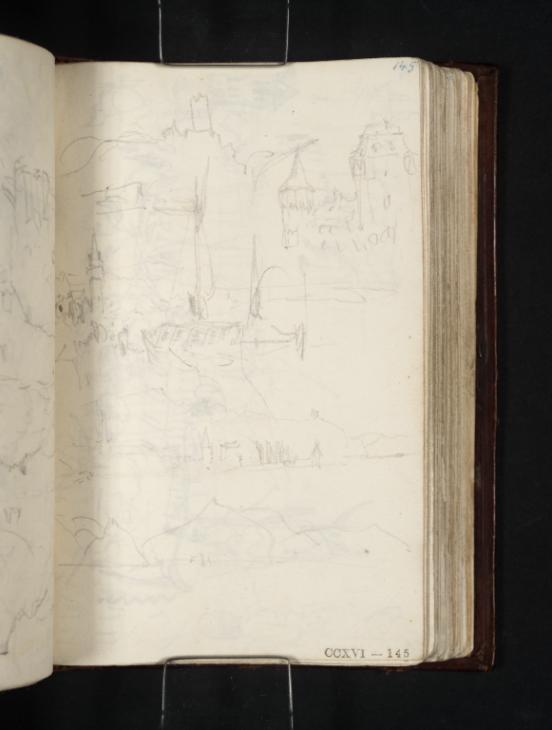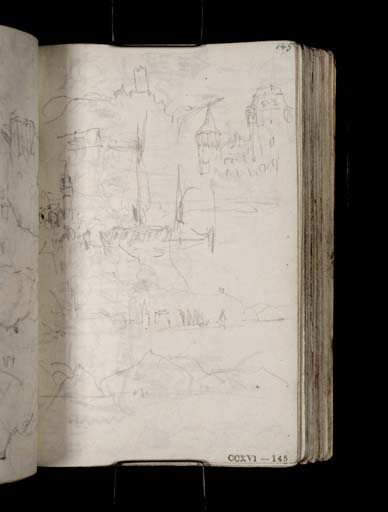Joseph Mallord William Turner Linz; Rolandseck and Drachenfels 1824
Image 1 of 2
Joseph Mallord William Turner,
Linz; Rolandseck and Drachenfels
1824
Joseph Mallord William Turner 1775–1851
Folio 148 Recto:
Linz; Rolandseck and Drachenfels 1824
D19840
Turner Bequest CCXVI 145
Turner Bequest CCXVI 145
Pencil on white wove paper, 118 x 78 mm
Inscribed in blue ink by Ruskin ‘145’ top right
Stamped in black ‘CCXVI–145’ bottom right
Inscribed in blue ink by Ruskin ‘145’ top right
Stamped in black ‘CCXVI–145’ bottom right
Accepted by the nation as part of the Turner Bequest 1856
References
1909
A.J. Finberg, A Complete Inventory of the Drawings of the Turner Bequest, London 1909, vol.II, p.675, as ‘ Views on Rhine. (Perhaps Argenfels)’.
1978
Agnes von der Borch, Studien zu Joseph Mallord William Turners Rheinreisen (1817–1844) (Ph.D thesis, Rheinischen Friedrich-Wilhelms-Universität, Bonn 1972), Bonn 1978, p.85.
1991
Cecilia Powell, Turner’s Rivers of Europe: The Rhine, Meuse and Mosel, exhibition catalogue, Tate Gallery, London 1991, p.43 note 31 [p.60].
1995
Cecilia Powell, Turner in Germany, exhibition catalogue, Tate Gallery, London 1995, p.33 note 16 [p.77].
These cursory sketches show aspects of the towns of Linz and Rolandseck and the Drachenfels (‘Dragon’s Rock) hill, at the summit of which lies the vestiges of Drachenfels Castle. Pictured in profile in the uppermost sketch, the castle dates back to the 1130s and was constructed to defend the Archbishop of Cologne’s territories. Protestant Swedes bombarded it in 1634 during the Thirty Years War and the fortress was left in ruins. Dragon’s Rock and its castle were slowly eroded by time, weather and quarrying, and yet, owing to its decaying appearance, the site gained aesthetic importance, becoming an icon for the so-called ‘Rhine Romanticism’ movement. Poets such as Edward Bulwer-Lytton and Lord Byron wrote about Drachenfels, the latter including it in the Third Canto of his Childe Harold’s Pilgrimage (1812–8):
The castled crag of Drachenfels
Frowns o’er the wide and winding Rhine,
Whose breast of waters broadly swells
Between the banks which bear the vine,
And hills all rich with blossom’d trees,
And fields which promise corn and wine,
And scatter’d cities crowning these,
Whose far white walls along them shine,
Have strew’d a scene, which I should see
With double joy wert thou with me.1
Frowns o’er the wide and winding Rhine,
Whose breast of waters broadly swells
Between the banks which bear the vine,
And hills all rich with blossom’d trees,
And fields which promise corn and wine,
And scatter’d cities crowning these,
Whose far white walls along them shine,
Have strew’d a scene, which I should see
With double joy wert thou with me.1
Parts of Linz, meanwhile, are depicted in the details near top right: the Rhine Gate at right, with a mansard-type roof, and the conical tower of Linz Castle, with its narrowly tapering spire, at right. At centre Turner records a riverboat with nimble handling, and includes two small figures by the side of the vessel. A church can be seen in the background, possibly that dedicated to St Martin at Linz. The lowermost views are very slight and show either Linz or Rolandseck and the Drachenfels at rear from the river.
The Rolandseck and Drachenfels are depicted elsewhere by Turner in the following: Tate D12572, D12768–D12775, D12863, D12866–D12867, D12885, D12887, D28615–D28616, D28623, D28625–D28626, D29715, D30500–D30506; Turner Bequest CLIX 30a, CLX 35aa–39, 83, 84a, 84a–85, CLXI 2, 3, CCXCI 40a–41, 44a, 45a–46, CCXCVI 61a, CCCIII 22–25. See also Tate impression T04779 for an engraving after Turner’s illustration of Rolandseck and Drachenfels for Campbell’s Poetical Works, and Tate impression T06180 for an engraving after Turner’s watercolour of Drachenfels of 1830 (Manchester City Galleries).2 In addition, there are two other highly finished watercolour drawings in the collection of the Courtauld Gallery, London and at the Cantor Arts Centre, Stanford University, California.3
Alice Rylance-Watson
June 2014
George Gordon Byron, Bt., Childe Harold’s Pilgrimage, Canto The Third, stanza LV; see the full poem online at Project Gutenberg, accessed 14 June 2014, http://www.gutenberg.org/files/5131/5131-h/5131-h.htm#link2H_4_0005
How to cite
Alice Rylance-Watson, ‘Linz; Rolandseck and Drachenfels 1824 by Joseph Mallord William Turner’, catalogue entry, June 2014, in David Blayney Brown (ed.), J.M.W. Turner: Sketchbooks, Drawings and Watercolours, Tate Research Publication, April 2015, https://www


